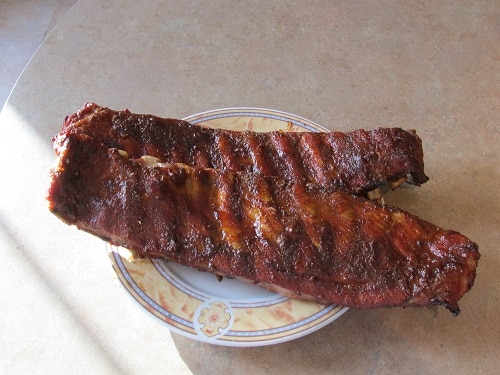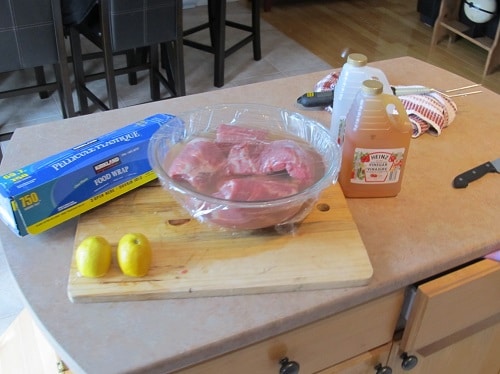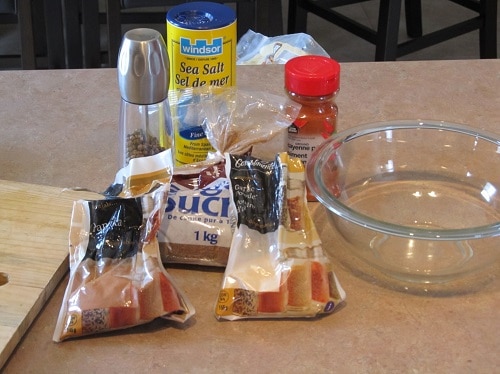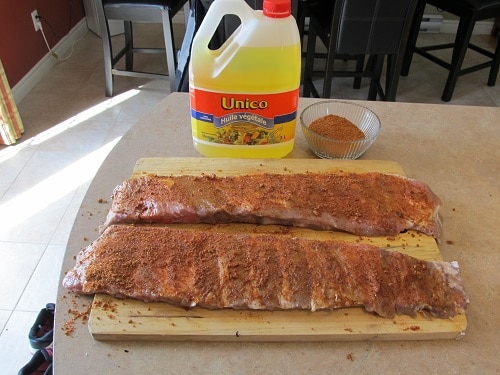
Learning basic cooking skills was not a priority for me while growing up. The transition from a fully fed teenager to a totally independent and clueless in the kitchen college freshman was painful. I quickly lost my appetite for fast food and frozen dinners. Luckily, something about outdoor cooking had always intrigued me. I began reading about grilling techniques and quickly got hooked. Grilling introduced me to the art of preparing great meals. Today I consider cooking one of my greatest passions.
There is good reason why pork ribs are such a dominant fixture on the competition grilling circuit. Cooking delicious ribs shows a great command of the barbecuing process. This may sound intimidating, but the best thing about cooking ribs is that it comprises a series of simple steps you can master and reap the delicious benefits.
How to Purchase Pork Ribs
Pork Ribs are widely available at your local supermarket, meat market, or wholesale grocer like Costco. If you are a Costco member, I highly recommend purchasing ribs there. They offer high-quality meats at an affordable price.
Although there are seemingly endless types of pork ribs with a variety of labels, in reality there are only three types to consider.
Baby Back Ribs
These ribs are commonly referred to as loin ribs, back ribs, or Canadian back ribs. Taken from the top of the rib cage between the spine and the spareribs, baby back ribs are shorter and meatier than spareribs and take less time to cook.
Spareribs
Referred to as spareribs or side ribs, these ribs are taken from the belly side of the rib cage, below the baby back ribs area and above the sternum. Spareribs yield less meat than baby back ribs and contain more fat.
St. Louis Style Ribs
These are spareribs with the sternum bone, cartilage, and rib tips removed. After being cut, St. Louis style ribs have a rectangular shape.
How to Prepare the Ribs
Rinse and Cut
It may seem obvious, but this needs to be pointed out. The first step is to rinse the ribs under running cold water; making sure to get rid of any loose meat, fat, or bone particles. After rinsing, blot the slab dry with paper towels.
Cut off any dangling pieces of meat or fat. If these pieces are kept on the slab, they will burn and leave burn marks on your ribs.
On the bone side of the slab, you will notice a tough membrane covering the bones. Remove this membrane by getting between it and the meat at the wider end of the slab and ripping it off all the way to the narrow end.
Marinate

Although the effectiveness of marinating pork ribs is debatable, I like to marinate them for a few hours before cooking as follows:
- Place the ribs in a large, non-reactive roasting pan or a large bowl
- Pour 3 to 4 cups of apple cider vinegar over them; enough to cover the ribs completely
- Cut and squeeze the juice of 1 lemon directly into the bowl
- Cover bowl with plastic wrap and place it in the refrigerator for 1 to 2 hours
Apply a Dry Rub

Applying a dry rub to your ribs is essential. The combination of salt, sugar, herbs, and spices will enhance the meat’s flavor, add some heat, and help promote a tasty surface crust. Use the following rub, make your own, or go with your favorite store-bought variation.
This recipe makes about 1 cup. Combine all of the ingredients in a bowl and mix with your hands. Store the remaining rub in an airtight jar away from heat or light; it will keep for at least 6 months.
Ingredients
- 1/4 cup firmly packed brown sugar
- 1/4 cup paprika (hot paprika for an extra kick)
- 3 tablespoons black pepper
- 4 tablespoons salt (preferably coarse salt)
- 2 teaspoons garlic powder
- 2 teaspoons celery seeds (optional)
- 1 teaspoon cayenne pepper
Remove marinated ribs from the fridge and blot dry with paper towels. Apply a thin layer of vegetable oil to the ribs. The flavors in most dry rubs are oil soluble so this step will help the rub penetrate the surface of the meat. Apply a generous amount of the rub to both sides. Finally, wrap the ribs in foil or plastic wrap and refrigerate for at least 1 hour.

Let’s Grill!
In this article, I describe the process of grilling spareribs with smoke on a gas grill. The meaningful differences when using a charcoal grill are in the way you set up your grill and how you apply the woodchips for the smoking process.
The only difference when grilling the different kinds of ribs is the cooking time; baby back ribs tend to cook a bit quicker due to their lesser fat content.
Grilling on indirect heat.
Ribs grill best with wood smoke and by cooking them slowly at low heat. We achieve this consistent low heat by grilling our meat indirectly. This simply means we turn up the heat on one side of the grill and we lay our meat down on the opposite side.
Indirect grilling on a gas grill.
Setting up your gas grill is pretty simple. If you have two burners, turn one of them on and leave the other one off. If you have three burners, turn off the two burners on the edges, or if you are having issues maintaining your goal temperature of 225 degrees, turn one of the edge burners on and leave the other two off.
Smoking with woodchips on a gas grill.
Smoke flavor makes your ribs even tastier! Simply follow the steps below and you will marvel at how rewarding it is to grill with smoke.




